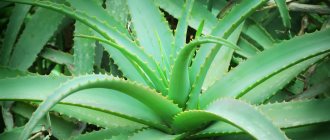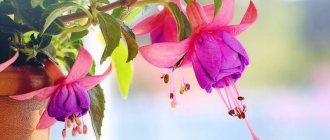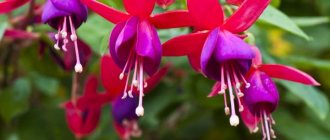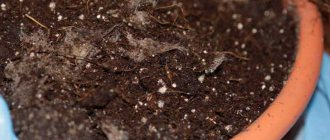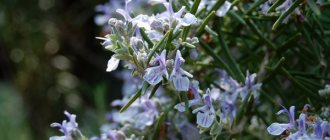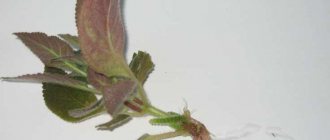Fuchsia is a graceful plant that is characterized as a dancing flower or a ballerina. Some call it a Japanese lantern, while others call it a fluttering butterfly. This indicates that fuchsia is a beautiful flower, which by its mere appearance sinks into the depths of the soul and heart, and is associated in our minds with something very pleasant.
Numerous flowers of the plant, which somewhat resemble cute little skirts, delight our eyes all summer. It is not surprising that the plant is so popular, because it blooms so beautifully. But this beautiful creation requires some effort and attention. To provide the plant with proper care, you need to know how to do it. This article will help you learn about growing and caring for fuchsia at home.
Description of fuchsia with photo
First of all, I would like to say that the Fuchsia genus includes approximately one hundred species of plants that belong to the Fireweed family. Its representatives live in the mountain forests of America, and are also found in Mexico, Argentina, Tahiti, New Zealand, Chile, Peru and the Falkland Islands. Under natural conditions, the plant always lives in partial shade, under the canopy of trees.
The leaves of the plant are opposite; their shape can be either lanceolate, ovate, serrate, or crenate or entire. The fruits of the plant are quite juicy, and somewhat resemble berries. The appearance of Fuchsia is either bushy or creeping. It has graceful flowers on thin stalks, which differ in different colors.
The main feature of fuchsia that gives it the greatest grace is the long, brightly colored stamens protruding outward and the prominent pistil style. All this makes the plant a unique creation.
Growing by seeds
If fuchsia is already sprouting at home, then you can take the seeds yourself. True, the seed selection procedure is problematic and time-consuming, but the process itself is very interesting. To be able to use seeds as planting material, you will need to pollinate the flower:
- Must be a mother and father plant. From the mother's plant, when the buds are opening, you need to carefully remove the anthers using tweezers, then remove the pollen from the father's bush and put it on the petals of the mother's. It is inconvenient to obtain fuchsia seeds using this method, because there is no certainty that all properties will be preserved.
- If there is only one bush in the house, then pollination is carried out on one plant. Pollen is taken from stamens of one color and placed on a pistil of a different shade. The necessary qualities are preserved.
- The pollinated buds are covered not with dense matter, but with gauze. Under the cover, the perennial fruit begins to sprout. This technique will not allow fuchsia to be pollinated by insects.
- When the fruit appears, the gauze is removed. Initially, the berry is red in color, after which it becomes purple and at the end of ripening the color is purple.
- It is recommended to pick berries when the sun is outside. Fuchsia seeds are carefully removed from the fruits and sent for drying, but care must be taken to prevent mold from appearing. The dried seeds are placed in sealed bags and stored in the refrigerator until spring.
If you don’t want to do the process yourself, then you should buy planting material in the store. You need to understand what fuchsia seeds look like before purchasing. Knowing what the seeds look like, you can start planting; it falls from February to April inclusive.
Fuchsia is planted in special soil; you can buy it or make it yourself. The composition of the soil is as follows:
- Sod land - 3 parts.
- Peat – 2 parts.
- Sand – 1 part.
The ingredients are mixed and placed in a small container. Before planting fuchsia seeds, the soil is moistened, lightly irrigated with potassium permanganate and compacted a little.
Fuchsia cultivation:
- The seeds are placed on the top ball of soil, not sprinkled with it, but simply pressed a little deeper. This condition is very important, because without light, seedling material will not appear.
- The seeds are small and to make sowing easier, it is recommended to add them to the sand.
- For quick germination, a greenhouse effect is created by covering the container with film or glass.
- The box is left in a warm and well-lit place, but out of the sun. For seedlings, the optimal temperature is from +18 degrees, but not more than 20.
When condensation forms on the glass or film, the cover is removed and the container is left for ventilation. Growing from seeds at home does not require much moisture in the soil, but if the soil dries out, it can be sprayed with a spray bottle. Water is used at room temperature.
Sowing seeds
The best time to plant fuchsia seeds is February, March or April.
The soil
The substrate used is fertile soil (3 parts), peat (2 parts), river sand (1 part). Mix all ingredients well and fill containers. If you cannot prepare the soil yourself, you can use ready-made soil for indoor plants.
Sowing seeds
How to grow fuchsia from seeds at home? Before sowing begins, the soil is spilled with boiling water. This will help get rid of pests and pathogenic bacteria. When the soil has cooled, make small furrows and lay out the seeds. There is no need to bury the seeds and sprinkle them with soil, and this is an important condition for the germination of fuchsia.
For easier sowing, seeds are mixed with sand and distributed over the surface of the soil, then moistened with a spray bottle. Containers with crops are covered with film or glass, leaving a small gap for air. From time to time, moisten the soil using a sprayer or syringe. Once a day, to prevent mold from appearing, glass for 15-20 minutes. cleaned up.
Germination
Containers with seeds are kept in a bright place, but out of direct sunlight. A comfortable temperature for seed germination should be between 18-20°C. Peat tablets can be used to germinate seeds.
After about 20 days, you can inspect the boxes for the presence of young shoots. The germination period can take up to 30 days, this factor depends on the fuchsia variety.
Important! There is no need to remove the film immediately; the seedlings must get used to the external environment. To do this, increase the time daily, after which the shelter is removed.
Care
Fuchsia has a huge number of hybrid forms with straight and pyramidal stems; there are ampelous and spreading varieties, hanging, climbing, in the form of bushes and bonsai. Fuchsia blooms profusely and for a long time with beautiful lantern flowers. We'll tell you how to care for indoor fuchsia at home:
Temperature
Comfortable temperature for growing fuchsia at home is 18 – 22 °C in summer and not higher than 18 °C in winter. If the temperature is above or below these limits for a long time, the decorative properties of fuchsia may suffer. The buds will begin to fall off, the leaves will become smaller and lighter. The plant will slow down its development. There will be a risk of infection by diseases and pests.
If the temperature during the active growing season of fuchsia drops below comfortable, the same effect will occur. The plant orients itself based on the ambient temperature. When it is warm and light, the flower actively develops and blooms profusely, usually from spring to autumn. At the end of autumn and winter, when it becomes cooler and there is less sunlight, the development of the fuchsia flower stops, buds stop forming - the fuchsia is preparing to rest.
Location
It is better to place flowerpots with fuchsia on the windowsills of the eastern and northern sides of the room. Even here, the flower must be protected, if necessary, from direct sunlight with the help of blinds or curtains. On north-facing windows in the spring, fuchsia may not have enough lighting. You will have to provide the bushes with illumination using a phyto lamp or a fluorescent lamp for up to 12 hours a day.
On southern windows, especially in the summer, fuchsia will be too hot. It is better at this time to take the flowerpot with a flower into the garden under the trees or onto the balcony, where the sun's rays will illuminate the fuchsia only early in the morning. At noon and until evening, fuchsia feels best in partial shade. During flowering, it is advisable not to move the flower from place to place and not to turn different sides towards the light. Fuchsia doesn't like this, and can simply drop all its buds.
Watering
Proper watering is the most important component of caring for blooming fuchsias. Many factors influence the frequency and quantity of watering a flower:
- Pot location
- Fuchsia variety
- Her growth stage
- Soil composition
- Pot size and type
- Weather
Without additional nutrition, fuchsia can survive for quite a long time, but without water it cannot. Fuchsia needs to be watered regularly. Make sure that the soil is well saturated with moisture each time. The next watering should be no earlier than the top layer of soil from the previous watering has dried out. Excess water from the pan must be drained to prevent moisture stagnation in the roots of the plant.
A flowering plant has a great need for moisture. In the summer, you will have to water frequently and regularly - every 3-4 days, and sometimes more often.
If the fuchsia looks drooping and the soil in the pot is wet, the problem is not watering. Perhaps your beauty has overheated.
In autumn, watering is gradually reduced to once a week, and in winter, watering is done no more than once or twice a month.
Feeding
Fuchsia needs to be fed regularly, once every two weeks. This is especially important during the active growing season, from April until autumn. For feeding, complex fertilizers for ornamental flowering plants are used. Watering with liquid fertilizers must be done on moist soil. Fertilizing helps fuchsia grow green mass and form countless buds. You can also use foliar feeding of fuchsia on the back of the leaves.
During winter dormancy, fuchsia is not fed.
Young, newly planted fuchsia bushes do not need to be fed, as they are planted in well-prepared soil filled with all the necessary microelements and organic matter. The same rule applies when transplanting a plant into a larger pot with new nutrient soil. Feeding should be resumed about a month after transplantation.
Humidity and spraying
For fuchsia, air humidity is comfortable within the range of 50 – 60%. Too dry indoor air will cause fuchsia leaves and buds to yellow and wilt. You can increase the humidity of the surrounding air using wide containers of water placed next to the fuchsia. You can also place the flower pot in a tray with wet pebbles or expanded clay.
On hot summer days, fuchsia will be saved from the heat by regular spraying with settled water at room temperature in the morning and evening hours. It would be good to take the fuchsia out into the fresh air in the garden, in the shade under the trees, or at least on the balcony, where the sun's rays reach only in the morning. But we must remember that this must be done carefully - after all, fuchsia does not like being moved from one place to another during flowering.
When spraying, try not to get the spray on the flowers.
Further care
Why do fuchsia buds fall off before they open?
Fuchsia seedlings develop well with proper care. Water the plants with settled water at room temperature. Moisturizing is necessary as the top part of the soil dries out.
Important! To prevent blackleg disease from appearing, use a slightly pink solution of potassium permanganate for watering or scatter wood ash on the soil.
When the second pair of leaves is formed, young fuchsias can be planted in separate containers with a diameter of 7-9 cm. Expanded clay should be placed at the bottom of the cups and small holes should be made to drain excess water. Using a pencil or other object, make depressions in the soil and carefully, holding the leaves, lower the fuchsias into them.
The transplanted plants are placed in a shaded place where the sun's rays do not penetrate for 1-2 days. This measure is necessary for better adaptation of the sprouts.
Fuchsia in a pot
Caring for plants is impossible without applying fertilizers. Fuchsias especially need additional nutrition during active growth and during the flowering period. For fuchsias, ideal, agricola, and zdraven are suitable. Moreover, all types of fertilizers can be applied only on moist soil.
Folk remedies can be used as additional nutrition.
- Banana peel in the amount of 3 pcs. pour 2 liters of water and infuse for 5 days. Next, the solution is filtered, diluted with water 1:1 and the flowers are watered.
- Wood ash (2 tablespoons) is poured into 1 liter of water. After 2 days, the nutrient solution is ready.
- Onion peel. This component is in every home. To fertilize fuchsias, just soak a handful of onion peels in a three-liter jar for 2 days.
- Castor oil (1 teaspoon) is added to 1 liter of warm water, shaken well and sprayed on the plant. This fertilizing promotes lush flowering.
- Aquarium water. This feeding is effective to use from early spring to mid-summer. Water from the aquarium only on wet soil, since it is also a fertilizer.
Trimming and pinching
Fuchsia flowers appear on young shoots. To increase the number of such shoots, the plant should be regularly pruned, and young shoots should be pinched. Pinching is a very effective method of making fuchsia bloom more abundantly. Using pinches, the desired shape is formed, giving the crown the appearance of a ball, bush or miniature bonsai tree.
Fuchsia, depending on the variety, grows to a height of three meters or more. It is difficult and impractical to grow such a giant indoors. If you pinch the plant in time, it will form into a strong and beautiful bush.
Indoor fuchsia should be trimmed twice a year: in the fall, at the end of the mass flowering of the flower (October), and in the winter (early January).
Fuchsia in the form of a tree
During the first, autumn, pruning, you will remove all faded fuchsia branches at a height of 2 cm from the dormant buds. Carefully inspect each branch for pests, remove excess seed pods and outdated flower stalks. If insect pests are found, cut off severely damaged parts of the flower and treat the entire plant with an insecticide.
Do the second pruning in early January to finalize the crown of the plant. If the fuchsia overwintered in the basement or garage, the plant has already been pruned in the fall. In spring, all that remains is to remove dry shoots and leaves from it.
If the plant has been in the room all winter, it must be trimmed. Use clean pruning shears or garden shears to remove any long, thin shoots as they will be of little use. They will not bloom luxuriantly, and your bush will not become more beautiful from them.
Fuchsia bonsai
If the plant is periodically pruned, it will grow in width instead of height. It is also better to cut off woody old shoots, since they consume nutrients and have almost no flowers. All flowers bloom only on young shoots. A strong and beautiful bush will soon form.
If you decide to form a bonsai from fuchsia, then leave only one shoot or, conversely, several such shoots that can be twisted together so that they act as the trunk of your tree. The tops must be pinched to form a lush crown of the bonsai.
What is the best way to pinch fuchsia so as not to harm its beauty and decorativeness?
If you want to form a tree from fuchsia, pinching should be done in winter, when the life processes of the plant slow down. Remove excess shoots, leave a few on the central stem. Look what happened in the spring. If the crown of the flower is not yet formed as you would like, prune it again in the spring.
You can trim the plant right to the stump. In this case, the fuchsia will sleep longer and bloom later, but a wide bush will form.
If the shoots are cut back by only a third, the fuchsia will turn into a tree and can take up a lot of space.
The shoots that grow in place of the old branches are pinched a couple of times as they grow. Fuchsia will then turn into a lush beauty and will delight you with abundant flowering.
If young branches are pinched above the third pair of leaves, tillering will increase. To enhance the effect of tillering, the regrown branches need to be pinched again, but now near the second pair of leaves.
You decide for yourself what you will grow from fuchsia - a bush or a tree!
Keep in mind that before fuchsia blooms, two months pass for the formation and development of buds. Fuchsias with small simple flowers bloom earlier than plants with giant inflorescences and large double flowers.
Landing
It is impossible to plant fuchsia or, especially, a cutting immediately into a large pot. It is necessary to increase the size of the pot gradually. At first, the pot should not be more than 9 cm in diameter. As the roots entwine the entire lump of earth and the need arises to replant the plant, you can prepare a slightly larger pot. Place a good layer of expanded clay or other drainage material on the bottom. Add a layer of soil and plant the prepared bush or cutting.
The pot must be well filled with soil to prevent voids between the roots and the walls of the pot. To do this, gently shake the pot and tap on its walls, but under no circumstances compact it with your hands. For fuchsia to grow, porous soil is as important as good drainage.
Soil preparation
The first thing you should pay attention to when growing this flower is the soil. It can be purchased at a flower shop. For fuchsias, ready-made specialized mixtures for flowering plants are suitable. They have a normal, non-acidic environment, which is ideal for growing strong and viable sprouts. Experienced gardeners prefer to prepare the soil mixture themselves. Today there are 3 known methods:
- a mixture of peat, perlite and sand. They are needed in equal parts;
- crushed sphagnum moss, humus (preferably rotted) and vermiculite to make the soil loose. The components are mixed in equal proportions;
- a mixture of turf, peat, pine bark, sand. The components are prepared in a ratio of 3:1:1:1, respectively.
Before planting, the soil must be disinfected. A weak solution (light pink) of potassium permanganate is suitable for this. During processing, thrips and nematodes are killed, and the likelihood of mold and pathogenic microflora formation is reduced. If you have a special drug “Fitosporin”, it will successfully replace a solution of potassium permanganate.
The container does not play a special role for growing seedlings. The most commonly used are plastic cups or wide containers. The main condition for a container is the presence of a large number of holes for water to drain. A drainage layer (2-3 cm) can be laid at the bottom of the container. Expanded clay or small pebbles are suitable for this.
Types and popular varieties
Over a fairly long period, many types of fuchsia have been bred. This article will only talk about a few.
Fuchsia hybrid
An upright or hanging shrub. It has quite bright flowers, which are distinguished by their large size. A distinctive feature of this variety of fuchsia is its differently colored cups and petals. This species has a large number of varieties. Among which are:
- Litte Bell, since the flowers of this variety somewhat resemble bells;
- Cecile - the shape of the flowers is reminiscent of the skirts worn in the fifties;
- Swingtime – the flowers resemble some unknown overseas birds.
Fuchsia hybrid
Fuchsia trifoliata
It is considered a rare type of fuchsia. A distinctive feature is the presence of rhizomes, elegant large foliage with a reddish-green color, short inflorescences, and finally, bright coral flowers. The fuchsia variety is quite hardy. Varieties: Bacon, Constance, Garden News. These varieties are winter-resistant and can be kept either in little or no shelter, or under snow.
Fuchsia trifoliata
Transfer
Taking fuchsia out of an old pot
Fuchsia is a fast-growing plant. Therefore, it must be regularly replanted into a pot of suitable size, which is 3–4 cm larger than before. It is better to do this every spring, when the flower begins to awaken and grow.
It’s better to take a ceramic pot so that it protects the plant’s root system from overheating in the summer heat. Don't forget about drainage. 2 - 3 cm of expanded clay or pebbles at the bottom of the pot will protect the roots of the plant from rotting. As a substrate, it is better to take a purchased soil mixture for flowering indoor plants.
You can also prepare the soil for replanting fuchsia yourself. To do this, mix leaf soil, turf soil, humus, peat and coarse river sand in equal parts. Replant using the transfer method: pour a little prepared soil into the pot on the drainage layer, then carefully remove the fuchsia from the old pot and place it in a new pot together with a lump of earth. Fill the voids on the sides with soil mixture.
After transplanting, place the fuchsia on a shelf with diffused lighting. Trim its stems to one-third of the length. Spray the leaves and water the substrate with settled water until excess water appears in the pan. After a few minutes, drain excess moisture from the pan.
After transplantation, no additional feeding is needed for a month!
Now wait a couple of months - abundant fuchsia blooms are guaranteed!
Why fuchsia picking
Grown bushes need to be pruned, that is, planted in separate cups or pots. This will prevent further intertwining of the roots of neighboring plants and their competition for mineral nutrition. Diving is possible when the first leaf appears on the plant, but it is better to carry out the procedure at the stage of two or three leaves.
Fuchsia has a fibrous root system. Plants of this type need to be pruned by pinching the main root by one-fourth . Cutting off the tip ensures intensive development of lateral roots and greater viability in a new location.
A bush with a trimmed root is lowered into a glass or pot of soil, where it will grow until the adult stage or before planting in open ground.
The replanting container must have drainage holes and a two-centimeter layer of pebbles at the bottom.
The soil is poured the same as that used for seed germination.
In the prepared recess for the sprout, carefully straighten the roots, sprinkle them with soil and lightly compact the soil. In this case, the soil should be watered abundantly to increase the contact of the roots with the soil. Planting depth is up to the cotyledon leaves; the root collar should not be hidden by the ground.
Not all gardeners consider it necessary to cut off the main root. Many people try to transplant the sprout directly with a lump of earth from the cell into a cup, adding soil from the sides and protecting it from any damage.
How to get seeds
The continuity of the existence of an exotic plant in our conditions can be ensured in three ways:
- obtaining from seeds;
- propagation by petioles;
- growing from a leaf.
Those gardeners who want to know in advance what will grow from a fuchsia seed prefer store-bought seed.
But amateur breeders are often driven by the desire to obtain an interesting hybrid through artificial pollination.
The selected plant from which seeds are needed must be deprived of the possibility of self-pollination. Therefore, all anthers from the stamens of blossoming buds must be carefully cut off. Then, using a squirrel paint brush, pollen from a flower of another plant is applied to the pistils.
After pollination, a bag is put on the bud , which is tightened with thread or twine.
This is protection against foreign pollen grains and loss of ripe seeds.
At home, this measure can be neglected, but if the plant is in the open air, fruits with seeds can become prey to birds or a gust of wind.
Bags can be:
- gauze;
- paper;
- from non-woven covering material.
The latter option is preferable when fuchsia is placed in open ground (for example, cold-resistant varieties “Ricartona” and “Fuchsia graceful”).
Overheating is possible in paper bags, and gauze bags stick together when wet. In a few weeks, dark, soft fruits will ripen. Then the bags are removed and the fruits are cut.
Carefully! You need to carefully remove fuchsia seeds from the fruit so as not to damage the seed.
The resulting seeds are dried for several days. This prevents rotting and improves germination. After drying, the seeds can be planted or stored.
Propagation by cuttings
Rooting cuttings in water is the main and most successful way to propagate fuchsia. The best time for cuttings is spring. Choose a young shoot from a fuchsia bush. The length of the cutting depends directly on the fuchsia variety. Usually they take from 10 to 20 cm. The point is that over time, the fuchsia shoots harden a little. If you take an old shoot for propagation, it will also take root, but this process will take longer. The young shoot will take root faster and will grow more actively in the future. Remove the leaves at the bottom of the shoot so that none of them comes into contact with the liquid in the container prepared for rooting. Also cut off large leaves completely or in half. The cutting does not yet have its own roots, and the leaves will draw all the moisture from it, preventing the root system from forming. Place the cutting in a jar of settled water and cover the top with a thick translucent bag. In 5 to 10 days, roots should appear. After a couple of weeks, the cutting can be planted in a prepared (preferably ceramic) pot with a nutrient mixture and drainage at the bottom. The size of the pot should be no more than 9 cm in height.
Rooting cuttings in water
If you decide to propagate fuchsia in the summer, keep in mind that it loves coolness and humidity. At high temperatures, a cutting placed in water may rot without ever sprouting roots. We advise you to root the cuttings in a room with air conditioning or a split system.
In autumn, fuchsia prepares for a dormant period. All life support processes of the plant slow down. So from September to January it is better not to propagate using cuttings.
The second method involves planting the cuttings immediately in a prepared substrate - in a peat tablet, in perlite, vermiculite or sphagnum. Be sure to place the planting material in a greenhouse or container with a lid to create a greenhouse effect, since such rooting requires high air humidity. As soon as the shoots take root, the greenhouse is opened slightly and the seedling is gradually accustomed to indoor conditions.
A sudden change in climate can cause the shoot to lose its leaves and die.
Autumn harvesting of cuttings
Autumn harvesting of cuttings is the best way to preserve fuchsia during the winter. In early autumn, take several cuttings from an adult healthy bush. They are suitable for propagating fuchsia. We take several cuttings as a safety net in case some of them do not survive the winter.
Cuttings need to be taken 15 - 20 cm in length, depending on the variety. They are stored in pots with soil in cool places, such as garages and basements. You can also save fuchsia cuttings on the bottom shelf of the refrigerator, in a bag of sawdust. Closer to spring, they are taken out, treated with a solution of potassium permanganate and placed in water for rooting. (see above)
Diseases and pests of fuchsia
Rust
- Root rot. When you notice that your fuchsia roots are becoming soft and brown, you can safely say that the plant is affected by root rot. It is very important to promptly determine the presence of the disease, so you will avoid the death of the flower. The main reason: waterlogging. Even good drainage will not help; stronger measures must be taken. Remove the plant from the pot, wash the roots under lukewarm water, cut off the affected parts, and place in a container with good, clean water. When new white roots appear, feel free to plant the fuchsia in a pot.
- Gray rot. Signs of the disease: the affected part becomes watery and soft. Reason: too humid air. When fuchsia is affected by gray rot, a coating will appear on its leaves. In this case, the affected parts should be removed, this should be done with extreme caution. Move the plant to a more suitable place with dry air. In this case, the plant should be ventilated periodically. If necessary, you can use purchased products to treat gray rot.
- Rust. Signs: A powdery rusty coating forms on the underside of the leaves. This indicates that the plant is sick with rust. If timely measures are not taken, then such a misfortune threatens all fuchsia flowers. Such spores are carried by the wind and can infect other plants that are nearby. Destroy the affected parts of the fuchsia, and try to spray fungicides twice in eight days.
- Whitefly. When the summer is hot, all the windows in the room are open, so the whitefly can easily fly into the room and lay its eggs on the leaves. You definitely won’t notice its arrival, since the butterfly is very small. As a result, small white droplets form on the plant, and they cannot be washed off with water. Otherwise, it will get even worse. Butterflies will begin to hatch from the eggs, the number of which will be quite large. They feed on fuchsia juice. As a result, the leaves turn yellow and fall off. This period will be fleeting, and soon the butterflies will begin to eat the plant stem. Action needs to be taken urgently. Wash the leaves with warm soapy water. It is very important to pay special attention to the inside of the leaf and the stem. Be sure to protect the fuchsia roots, as the soap solution will destroy them. If the stage of pest infestation is not so late, then several washes will be enough. If this does not help, purchase special products.
- Mite. It won’t take much time for such a pest to destroy a plant. Try to check fuchsia daily for the presence of this pest, especially if the room is dry and hot. Signs: matte leaves, yellowish, as well as small gray and black spots. You can also notice a cobweb on the plant. If the mite infestation is severe, the leaves will begin to fly off. Try to carry out repeated treatments; once will definitely not be enough. You can use “Fitoverm”, “Akarin”, “Agravertin”. Treatment (repeated) should be carried out three times, with a break of a week.
If you adhere to the basic rules of growing, then pests and diseases will not be able to destroy your plant. The main thing is to take preventive measures in time.
Fuchsia: growing from seeds without problems
Diseases and pests of fuchsia
When growing a flower from seeds, not everything always goes smoothly. Beginning flower growers may encounter a number of difficulties:
- Yellowing of foliage. If the lower leaves turn yellow, this is normal. When yellowness spreads throughout the plant, this is the result of pest activity. Lack of light, high air temperature, sudden climate change can also be a source of yellowing of leaves.
- Deficiency of iron and magnesium causes chlorosis, as a result of which the leaf blade begins to turn pale. In this case, the plant is fed with iron chelate.
- The leaves are withering. Loss of turgor most often indicates a lack of moisture. This happens during the period of active growth of fuchsia, and also when the flower is systematically flooded. Prolonged exposure to the sun also causes foliage to wilt.
- Few flowers. Poor flowering or its complete absence occurs as a result of heat, dry soil, lack of light, and poor wintering conditions. Buds may fall off due to changes in location and heat.
By following all the rules of care, you can avoid these troubles and grow a healthy flowering plant.
Fuchsia from leaf
The leaf is cut from the mother plant along with the petiole.
It is better to dip the cut tip into a growth stimulator, for example “Kornevin”.
Then the petiole is planted in a cup of soil and care is taken to keep it moist all the time.
Experienced flower lovers who know how to root a fuchsia leaf faster recommend covering the planting with another transparent cup. To prevent overheating and mold growth, the leaf is constantly ventilated.
After two to four weeks, the leaf turns into a bush. After full growth, it is placed in a permanent pot.
What do fuchsia seeds look like?
Fuchsia seeds are obtained from the fruit that is formed as a result of flowering. The achenes are very small, light brown in color, almost flat, and shaped like garlic cloves. In specialized stores you can purchase fuchsia seeds Foxtrot, Holiday, Bella Rosella. On store packaging there is a description of the characteristics of the variety that need to be taken into account when planting.
If you have mature flowering plants at home, you can get seeds for planting from them yourself. Step by step steps on how to do this:
- When the buds begin to open, remove pollen from the male flower with a cotton swab and transfer it to the female pistil.
- Pollination can be carried out between two different plants or on one, using several flowers.
- After the procedure, the flower is sprayed with water and covered with gauze. Moistening increases the chances of pollination, and the fabric will allow you to unmistakably recognize the fruit in which the desired seeds are ripening.
- The ripe fruit is carefully cut off and placed in a paper envelope.
- After the fruit begins to dry out, to prevent mold from appearing, it is placed in the refrigerator.
- Before planting, cut the berries and remove the seeds.
Fuchsia seeds
Important! The ripened fruit acquires a dark color.
Conditions
Knowing how to grow fuchsia from seeds, you still need to understand the growing conditions for bush, hanging and other types of perennials. In spring, it is better to take the pots into bright rooms, but where there is no direct rays of the sun. From the sun, the leaves begin to burn and fall off. There is an opinion that the darker and brighter the color of a plant, the more sunlight it needs. This rule should be used and if delicate shades predominate, then the shadow side of the house will do.
During active flowering, the pots do not need to be moved to preserve the flowers, which is the advantage of the plant. Some watering rules to pay attention to:
- The soil should not dry out; watering is carried out when the top 2 cm layer is dry.
- With insufficient or excessive watering, the color falls off.
- This type of plant loves moisture, so you need to frequently spray the perennial with a spray bottle. This procedure is done 2 times a day.
- Water is used that has been left standing for 24 hours.
It is necessary to create optimal temperature conditions for the shrub. Bushes do not like heat, so the temperature in the house should not exceed 22 degrees. In extreme heat, the bush dies.
In mid-autumn the leaves begin to fall, and in winter the bush does not need to be disturbed. It is recommended to place the pot in a cool, shady place where it will be 4-10 degrees. When all the sheets are reset, the pot is moved to complete darkness, and watering is significantly reduced.
When to plant seeds
It is believed that it is best to plant fuchsia in the spring: the optimal time for planting fuchsia seeds is March or April.
However, this is not a formula: there is evidence of a successful January planting. Moreover, by March the height of the bushes reaches ten or fifteen centimeters.
Note! Having outlined the month when you plan to plant seeds, it is worth taking into account the lunar phases. They are registered in lunar calendars. You need to focus on two weeks during the waxing moon (from new moon to full moon) - the above-ground parts of plants planted during this time period will be as dense and strong as possible.
Conditions for germination
An important condition for good seed germination is to ensure optimal environmental conditions:
- the room temperature should reach 23-26 degrees. Providing such conditions is much easier than it seems. It is enough to place a transparent lid or film over the pots, thereby creating greenhouse conditions;
- It is recommended to grow seedlings closer to the window so that the germinating flowers can be saturated with sunlight;
- It is recommended to ventilate the room daily;
- the soil must be moistened regularly.
Useful tips from experienced flower growers
In fact, fuchsia does not require much attention. The main thing is to understand something right away before you encounter a problem:
- In order for fuchsias to grow and develop normally, they need to be provided with a lot of light and an influx of fresh air.
- It is recommended to protect plants from direct sun.
- Fuchsias with rich colors require more light than varieties with light colors.
- Growing fuchsia with cuttings is even easier than with seeds.
- Frequent spraying will help young fuchsias grow actively.
- To enjoy flowering, you should maintain the room temperature to 20°C.
- If the fuchsia begins to stretch, it needs to be pinched.
- If plaque has formed on the soil, remove it and add new soil.
- The plant needs to be replanted into a container whose volume exceeds the previous one by only 4-5 cm.
Planting and growing fuchsia from seeds is not difficult. This beautiful plant will definitely thank the gardener with abundant flowering and will decorate any interior. But you will still have to make an effort for this, since you won’t be able to catch a fish out of a pond without difficulty!
Features of seed cultivation of fuchsia
Fuchsia is a perennial plant and is most often propagated at home by cuttings. However, many gardeners approach the process more creatively and grow the plant from seeds. This method of reproduction is very exciting and allows you to get offspring with interesting flower colors that are different from the mother’s. This can be explained by the fact that growing fuchsia from seeds does not guarantee that the young plant will retain most of the varietal characteristics inherent in the parent individual.
But for breeding purposes, the seed method is ideally suited and allows you to obtain flowers of various shades.
What to do in the fall
In the fall, you need to prepare the plant for winter dormancy. To do this, from September you need to gradually reduce watering. By the time frost sets in, fuchsia should be dry. Stop giving fertilizer so that the plant begins to shed all its greenery and flowers. Move the fuchsia to a place where the light is much weaker.
If suddenly the room is too dark, then simply turn on the incandescent lamp for several hours every day. It won't be hard work.
How to care for winter at home
After all the flowers and leaves have fallen from the fuchsia, it needs to be provided with optimal conditions for hibernation. Dig the plant bush out of the soil, doing this with extreme caution. Try to thoroughly shake off the remaining soil from the roots. Carefully inspect the fuchsia roots for rot and pests. If there are any, cut them off with a sterile knife.
Prepare the pot for hibernation. Wash it thoroughly and disinfect it. Fill the bottom of the container with a drainage layer, cover it with fresh soil, carefully place the fuchsia bush in it, and fill the voids with soil.
After completing all these steps, place the plant in a dark, damp place. The temperature should be no more than fourteen degrees Celsius. Try to follow all winter care rules, which include:
- Regular ventilation of the room. This should be done daily.
- Insulate the bottom of the container with polystyrene foam to prevent root rot.
- Make sure that the growing area always has moist air.
- Water no more than four times every thirty days.
- Before putting the plant into hibernation, treat the bush with a pest repellent.
- If suddenly there is no access to sunlight in the room, provide the plant with lighting using ordinary incandescent lamps.
